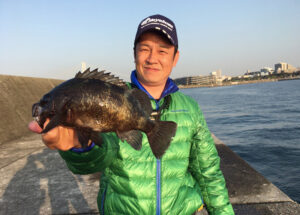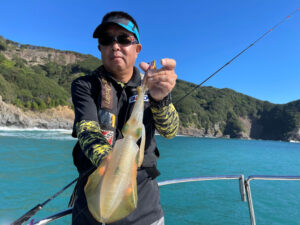Thick Skinned Cheater in the Sea, Kawahagi
For many Japanese sea fishing anglers, Kawahagi (leather fish or filefish) is a cheater. Their mouths are so small that it allows them to get baits without hooked. Anglers think that this Kawahagi is always stealing their bait from their hooks. But for game loving Japanese anglers, this fish turned into a good target to challenge. The difficulty to hook them made this game exciting and interesting. Of course what drives anglers is not only the fishing but also the cuisine you can make with it.
In this article, you will know why this fish is a nice target and how it attracts Japanese anglers. The first part is about the species, and physical characteristics of this fish. And the explanation about this fishing follows. At the end of this article, you will get some information about cuisine by using this leather fish.
Species
Kawahagi (thread-sail filefish or leather fish, Stephanolepis cirrhifer) is distributed in the western Pacific coast, Japan, Korea, and China. It lives near the coast, to the depth of 50 meters, mostly near the bottom with a mixture of rocks and sands.
It is covered with thick skin, while the color patterns vary depending on the environment. It has a strong stinger fin on its back. While a male has the thread shaped elongated fin on its back, female individuals miss it. These features are the origin of the English fish name.
In terms of the Japanese name of the fish, Kawahagi literally means ‘to peel the skin off.’ I find it interesting to see that the Japanese named this fish from the way they cook, while the English name is from its appearance.
It spawns in the period of May to August, on seaweed. Up to around 10 cm length, they form groups in the water, but as they grow they live more independently. It grows up to 20 to 25 cm, and a piece more than 30 cm is rare to get caught.
The first noticeable feature, from an angling point of view, of its characteristics is the special shape. It has a very small mouth in comparison to its total body size. In natural environments, it feeds on various kinds of food sources. It is said that it eats worms (Annelid species), crustaceans (shrimps and small crabs), clams (Japanese short neck clam, or Lajonkairia lajonkairii), jellyfish, sea urchins, and seaweeds. Inside its mouth, there are many strong teeth to grind the hard foods. These various foods may be the result of this fish’s strong curiosity.
It does not gulp the whole bait, but it bites on the bait and bit it by small pieces. It means that it can eat bait on the hook without swallowing the entire hook.
Another interesting characteristic is the way it swims. It is not a fast swimmer, but it can move freely to entire directions. Forward, backward, upward and downward. It moves using the dorsal fins, just like a helicopter in the water.
It gives this species a great advantage in combination with the way of eating food. This swimming capability allows it to eat the bait, in small portions. It can bite on the small part of the food and tear it off with moving away from the bait. It contrasts with many other species, in that many others swim forward to bite and shake its head side to side while it uses forward propulsion.
Fishing for Kawahagi
From the information above, you can imagine how hard it is to hook the fish. This is a fish to annoy anglers but on the contrary it is a nice enemy to compete against as a game.
The most popular way to catch it is from the boat. It is a kind of a paternoster rig with the sinker weight 100 to 120 grams (25 to 30 gou.) The special features of the rig lies in the attractiveness or flashes it has. It has special reflective plates on the top of the rig and often the sinker for this fish is painted with bright colors.
And the next important key in this rig is the hook. We have a specific shape for Kawahagi. It can hold the most popular bait of peeled clam well, and it can be well swallowed into its mouth.
As for the game, it requires the best sharpness all the time to make sure of the hooking. For this purpose, Japanese anglers thought out to replace the hook with each fish. Once you get a fish on the boat, the angler takes the branch leader off from the rig main line, instead of unhooking. How can you do it?
The image below tells you how.
You might think targeting this fish is very geeky. Actually, it is one of the very popular targets in Japan, especially in Tokyo bay. According to this site, about 50 to 60 boat captains are offering Kawahagi fishing in its high season, mostly winter, only around the Tokyo bay area.
Are you calling yourself an advanced angler? Then you should come to Tokyo in winter to enjoy the game against this thick skinned cheater.

